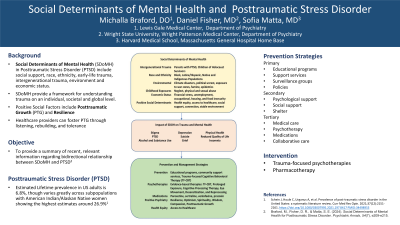Diversity, Equity, and Inclusion
(078) The Social Determinants of Health and Posttraumatic Stress Disorder

- MB
Michalla B. Braford, DO (she/her/hers)
Resident Physician
Lewis Gale Medical Center
Natural Bridge Station, Virginia 
Daniel Fisher, MD
Resident
Wright State University
Oakwood, Ohio
Sofia E. Matta, MD FAPA FASAM
Sr Director of Medical Services MGH Home Base
Harvard Medical School
Charlestown, Massachusetts- DJ
Dilip V. Jeste, MD
Director
Global Research Network on Social Determinants of Health
La Jolla, California
Presenting Author(s)
Co-Author(s)
Recognizing and addressing posttraumatic stress disorder (PTSD) is essential for the practice of psychiatry. Experiencing traumatic events and subsequent development of PTSD profoundly affects individuals, families, and society, making it one of the most common mental health disorders with substantial psychiatric comorbidity (Schein et al., 2021) This clinical review provides a brief analysis on sociocultural factors in the development of PTSD with emphasis on treatment strategies. The diagnostic criteria, prevalence rates, and the repercussions of PTSD on both an individual level and within society are discussed along with the advantageous and detrimental impact of social determinants of health in the development of PTSD (Herd et al., 2023). Clinicians are encouraged to incorporate social determinants in assessment and treatment planning with emphasis on certain modalities such as prolonged exposure (PE), cognitive processing therapy (CPT), Eye Movement, Desensitization and Reprocessing (EMDR), trauma-focused and grief therapy (Schnur et al., 2024) . Lastly, public health considerations are highlighted along with positive changes seen in posttraumatic growth in certain populations exposed to traumatic events (Tedeschi et al., 2015) . As clinicians begin to understand the role of the social determinants of health in regards to PTSD, the therapeutic alliance between doctors and patients is strengthened which allows for greater effectiveness in therapeutic interventions.
Schnurr PP, Hamblen JL, Wolf J, Coller R, Collie C, Fuller MA, et al. The Management of Posttraumatic Stress Disorder and Acute Stress Disorder: Synopsis of the 2023 U.S. Department of Veterans Affairs and U.S. Department of Defense Clinical Practice Guideline. Ann Intern Med. Published online February 27, 2024. doi:10.7326/M23-2757
Tedeschi RG, Calhoun LG, Groleau JM. Clinical Applications of Posttraumatic Growth. In: Positive Psychology in Practice. ; 2015:503-518.
Presentation Eligibility: Not previously published or presented.
Diversity, Equity, and Inclusion: Historically, certain marginalized groups appear to be at higher risk of developing PTSD with lifetime prevalence highest among Blacks and Latinx/Hispanics. Sadly, individuals from all minority groups are less likely to seek PTSD treatment compared to Caucasian/White individuals. Educating providers on the disparities faced by minority groups can assist in improving screening and interventions for marginalized groups who suffer sequelae from traumatic exposures.

